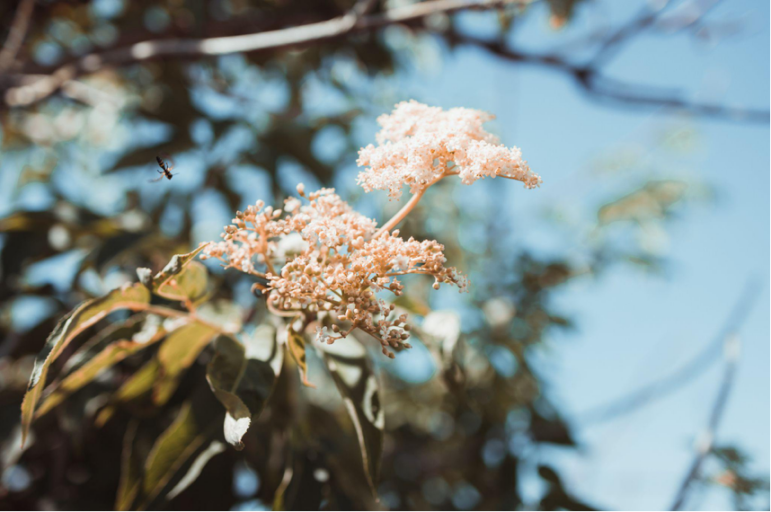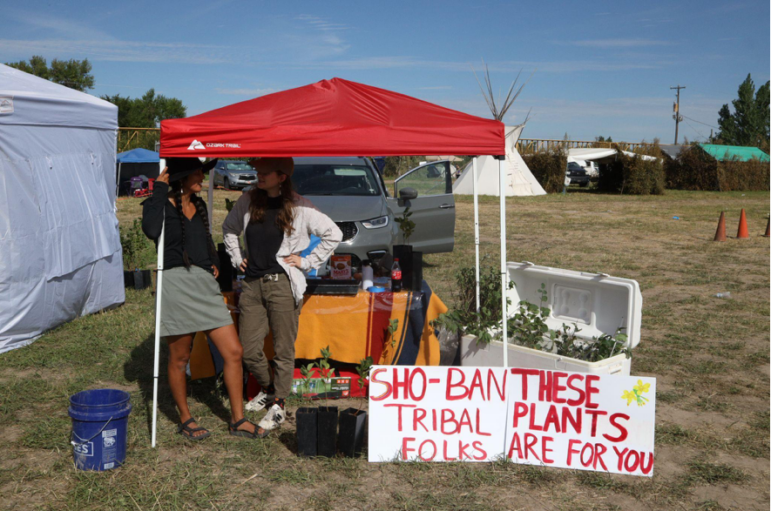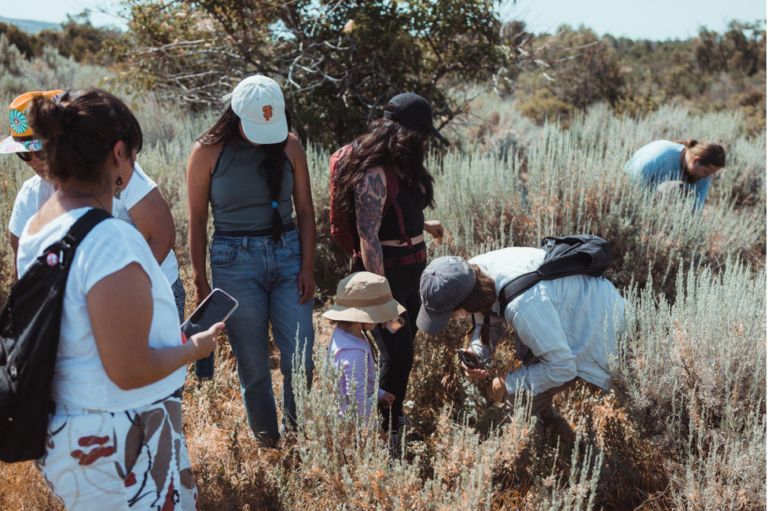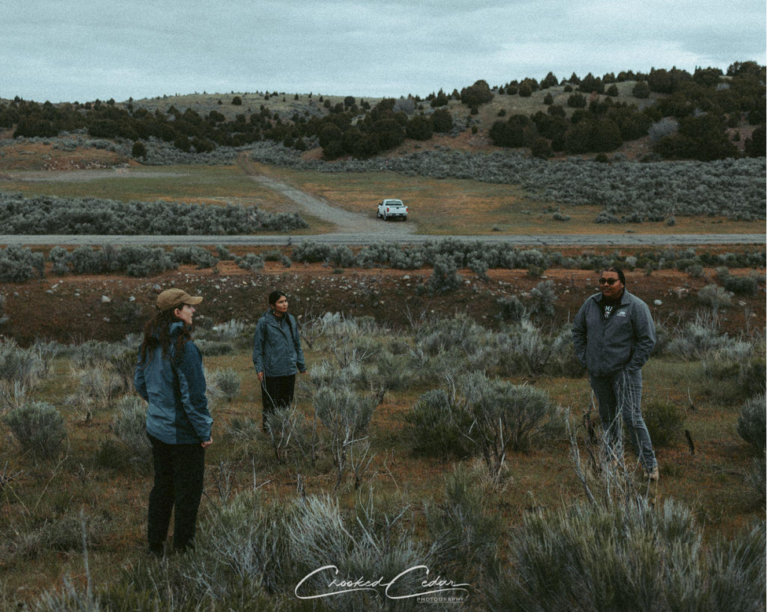Authors: Sidney Fellows, Christina Stucker-Gassi, Choice Vaughn, Nolan Brown
In collaboration with our member organization, Alternatives to Pesticides, Endangered Species Coalition has supported photographic documentation of the Fort Hall Native Plant Distribution Project by the Shoshone-Bannock Tribes. Please read the following article, describing this collaborative, Tribally led project, and to see the work of Choice Vaughn, project photographer.
In the summer of 2022, I took a walk with a group of fellow Shoshone-Bannock Tribal members and other friends and colleagues in the foothills of the Fort Hall Indian Reservation. The Shoshone-Bannock Tribes are made of Sosoni [Shoshone] and Panakwate [Bannock], collectively we identify ourselves as newenee, a plural term meaning human beings, or native people, and newe (pronounced with an ‘eh’ sound like the e in roses). Newe is a term used as either a noun or an adjective, such as the Shoshone word newe-dekape [native-food]. Our group visited the plants who give us our traditional newe-dekape [native foods], medicines, and fibers (figure 1). Tsiavui or Tsiambi (Rosa woodsii), Teavui or Deambi (Amelanchier spp.), Hupui or Weda’a Dekappe (Sambucus cerulea)(figure 2), and other unripe berries had our attention; we shared questions, observations, and knowledge about these plants who have been taking care of our people, and us them, for millennia. Months before the walk, the Northwest Center for Alternatives to Pesticides (NCAP) sought out recommendations from the Shoshone-Bannock Tribes to adapt existing projects, originally designed for native plant habitat installations to increase pollinator health and biodiversity, to the cultural needs of the Tribes. In doing so, the Fort Hall Native Plant Distribution Project was created as an effort to support tribal access to native plants.

Earlier that summer, four Tribal members were recruited by NCAP to help kickstart the Fort Hall Native Plant Distribution Project. In August 2022, Christina Stucker-Gassi (Euro-American; NCAP Healthy Food & Farms Program Manager), Choice Vaughn (Shoshone-Bannock), other community members, and I (Shoshone-Bannock, Chippewa-Cree; NCAP Program Specialist) organized to distribute free native plants, aka traditional newe-dekaape [native foods], medicines, and fibers, at the Shoshone-Bannock Tribes’ 57th Annual Indian Festival (figure 3). We held our second distribution the following year at the 58th Annual Shoshone-Bannock Festival. According to Shoshone-Bannock Creation stories, we have evolved with native plants since time immemorial. Similar understandings are found in other Indigenous communities across the world and in Western science. The plant-human connection happens through food, medicine, and fiber uses, but also through cultural practices, such as song and ceremony, that contribute greatly to the identity and health of Shoshone-Bannock Newenee.
Leading up to the 2022 Festival, the group of Tribal members and NCAP staff gathered throughout the summer to learn about plant practices and discuss elements that would enrich the Fort Hall Native Plant Project. Suggestions brought forward by Tribal members included more organized plant walks that encourage the transmission of knowledge and greater access to plants and seeds. The input from our Fort Hall community members guided our work’s focus and set new commitments around plants and the community into motion.
In spring 2023, NCAP continued building partnerships with the Shoshone-Bannock Tribes around culturally significant plants. Because of previous conversations between the NCAP team and Tribal interest in the historic staple food Teva or Deva (Shoshone and Bannock name for Pinus monophylla), Nolan Brown (Shoshone-Bannock Language and Culture Preservation Department [LCPD] Original Territories and Historical Researcher Manager), Carolyn Smith (Cultural Resources Coordinator for the Tribes’ Heritage Tribal Office/Cultural Resources), Louise Dixey (LCPD Cultural Resources Director), and other Tribal members considered how Deva could become accessible to current and future generations. We considered additional, related goals of the Tribes as well. For instance, the Tribes’ responsibilities and rights to hunt and gather on unoccupied lands, as declared by the Tribes’ 1868 Fort Bridger Treaty under Article 4, requires adequate populations and resources to do so, since the stipulation goes on to say, “so long as the game may be found thereon”. (Game refers to animals, plants, and other sources of livelihood and culture). For game to be found, and in this case Deva, the Tribes efforts to preserve and protect such traditional foods must remain dynamic to ensure plants, animals, waters, and other nonhuman persons are sustained. Additionally, Deva conservation addresses threats to the tree such as black stain mold, pine beetles, extreme heat events, and increases in wildfires. Thus, the Pinyon Project was born.


Through research, conversations with tribal partners and scientists, a story of a successful Deva transplanting at Fort Hall from a Shoshone-Bannock resident, and walks across landscapes suited for the tree (Figure 4), we decided to install a grove of Deva saplings onto the reservation. The intentions of the Pinyon Project are to increase tribal access to the plant, increase food production for future generations on the reservation (trees produce pine nuts around age 25), and uplift cultural practice in the community. A community planting is scheduled for Fall 2024 and our Pinyon team is working to make the planting educational, integrating knowledges from Western science around planting logistics and from our Shoshone-Bannock cultural practices that encourage human relationality to the Earth. This project is a great investment that NCAP and the Tribes will continue to develop and care for.



0 comments on “Shoshone-Bannock Tribes and the Fort Hall Native Plant Distribution Project.”